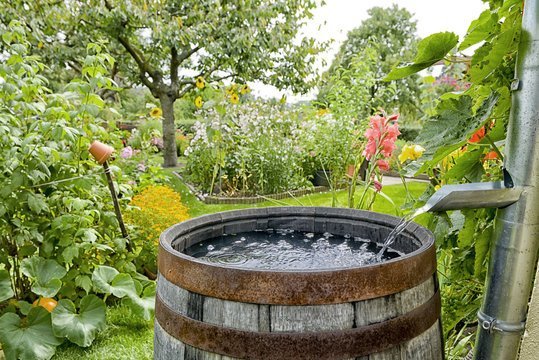http://www.rainwater-barrels.com/rain-barrel/
Rain Barrels and Sustainable Gardening
With environmental sustainability at the forefront of everyone’s minds, rain barrels are an integral part of gardening in an earth-friendly way. Stormwater runoff causes major pollution problems, leaching nutrients and chemicals into the wastewater treatment system. Additionally, massive amounts of stormwater drain directly into rivers, oceans and lakes, upsetting the oxygen balance, dumping lots of nutrients and causing fish kills and algae blooms.
Collecting runoff from the roof in a rain barrel helps divert stormwater runoff from water treatment or from flowing directly into lakes, rivers and streams.
Adjusting Fertilizer Use
In addition to collecting rain water in rain barrels, gardeners can help improve their environmental impact by changing the way they apply fertilizer. Using compost is one way to cut down on nitrogen leaching into water systems. Compost is broken down slowly by microorganisms in the soil, which means that nitrogen is more slowly made available to plants, and is more likely to bind to the soil, staying out of the water system.
Slow release fertilizer is also a good choice for lessening the amount of nutrients released into water systems. These fertilizers also break down gradually over time, not releasing more nitrogen than plants can use.
Planting Rain Gardens
Rain barrels can collect and divert many gallons of rain water each year. However, because one rain barrel can hold only 65 gallons of rain water, when a roof might produce as much as 200 gallons of runoff from a single storm event, a backup plan is necessary.
Rain gardens placed “downstream” from the rain barrel can absorb and treat overflow from a major rain event. Plants planted in rain gardens need to be able to withstand periods of heavy rain and water, followed by drought. For more information about rain gardens, visit our rain garden article. [LINK TO RAIN GARDEN ARTICLE]
Use Water Bottles
While using a refillable water bottle might not seem to be connected to rain barrel use, but a rain barrel is, in a way, a giant water bottle. Water bottles are a massive filler of landfills. Many states are banning plastic water bottles from ending up in landfills. However, recycling these bottles still uses a lot of energy and resources. Using a water bottle saves money, energy and the environment.
Make your Own Compost
If you can handle saving and harvesting rain water, a compost bin is the next logical step. Composting your vegetable food scraps is a great way to save water and make your own soil. Only compost plant materials. Vegetable scraps, coffee grounds, tea bags (without plastic components), shredded junk mail, dryer lint (from 100% cotton garments), and rinsed egg shells are good additions to the compost pile. Add grass clippings and shredded leaves, and you can create your own soil.
Compost is an excellent mulching material that breaks down to return nutrients to the soil. Make sure that the compost is not giving out heat if you spread it around your plants. You can also dig compost into new flowerbeds, and let them sit for a couple of weeks while the compost breaks down. It will provide a nutritious area for new vegetable plants.
Rain Water Harvesting: A word of caution
Rain water is perfect to use for many gardening tasks. One use that you want to reserve new, clean water for is watering the vegetable garden. This is especially true if you have a copper or asphalt roof. Those roofs can be treated with chemicals and heavy metals that are dangerous when taken up by vegetables and consumed.
Harvesting rain water is a good way to garden in an environmentally friendly way.


